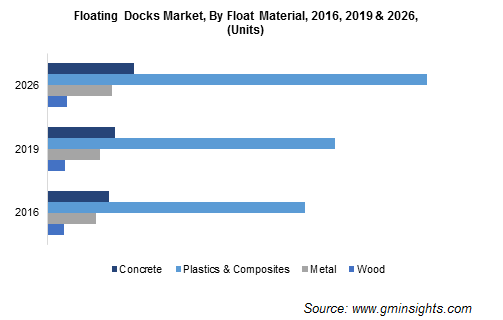Floating Dock Market demand worth $440 Mn by 2026
Published Date: March 2020
Floating Dock Market size is expected to cross USD 440 million by 2026, according to a new research report by Global Market Insights Inc.
Floating docks are getting widely popular for their usage on lakes and ocean bays due to their numerous advantages. These docks can be easily customized as per customer requirements in different shapes such as straight line, L-shape, U-shape, etc. Floating docks are adaptable to rising and falling water levels thereby providing superior flexibility. Additionally, these docks are easy to install & remove, and are inexpensive in nature. Floating docks provide more space for boat parking while giving people higher access to the area.
Increasing recreational activities will drive the product sales in future
Rising popularity of recreational activities and water sports are likely to spur the floating dock market growth. These docks are used for boats used in various water-based activities such as canoeing, kayaking, rowing, water skiing, etc. Additionally, these can also be used as a relaxation space. Changing consumer perceptions towards leisure boating will accelerate the pace of recreational sector. Additionally, financial support by the governments and favorable regulatory policies will support the growth of recreational sector thereby providing a positive outlook for the floating docks industry growth.

Get more details on this report - Request Free Sample PDF
Different factors such as skid resistance, water absorption, fire resistance, support, weather resistance, surge, uplift, etc. are considered during selection of deck materials. Metal deck segment will cross 14,000 units by 2026. Metal decks are usually heavier than wood decks and not suitable for usage in less developed settings. These decks are preferred for heavy traffic areas in developed settings. Metal grating or aluminum sheeting on decks offer required traction during muddy & wet conditions. These decks have longer service life than wood decks used for heavy use conditions.
The report forecasts, wood frame material will clutch over 27% of volume share through 2026. Although metal frames are used on large scale, wood frames are used for their financial viability. These frames offer flexibility during installation & repair work. Replacement of rotten wood frame is less expensive & time consuming than replacing a rusted metal frame. Dock frames are continuously in contact with water thereby susceptible to damage. Untreated woods used for framing may last for only 2 to 3 years however pressure treated woods with preservatives are recommended in the long run.
Browse key industry insights spread across 220 pages with 296 market data tables & 22 figures & charts from the report, “Floating Docks Market Size By Deck Material (Wood, Metal, Plastics & Composites, Concrete), By Frame Material (Wood, Metal, Plastics & Composites, Concrete), By Float Material (Wood, Metal, Plastics & Composites, Concrete), By Application (Residential, Commercial, Industrial, Government), Industry Analysis Report, Regional Outlook, Growth Potential, Price Trends, Competitive Market Share & Forecast, 2020 - 2026” in detail along with the table of contents: https://www.gminsights.com/industry-analysis/floating-docks-market
Floating dock market from concrete deck material segment will cross USD 70 million by 2026. These floats are generally constructed by surrounding a block of Expanded Polystyrene (EPS) with reinforced concrete. These types of floats are mostly used in marinas and large dock construction projects. These floats are heavy, tough and extremely stable in water; however, their costs are much higher than other materials. These floats do not release any toxins in the water thereby protecting the marine ecosystem.
Floating docks are used for various industrial applications such as shipbuilding & repair, on-water construction sites, transfer station docks, floating pumping stations, etc. The docks used for such applications are generally made of concrete and metal materials for the provision of optimum strength. These floats are useful in stabilizing equipment, movement of parts, transportation of working crew and to access a remote job site.
North America will capture majority of market within the forecast period
North America’s floating dock market will be characterized by favorable trends associated with shipping industry and marine construction projects. In addition, the product is expected to garner demand from regional naval and marine security sector. The market’s growth will be driven by rising expenditure on marine leisure activities. High living standards, increasing spending propensity and lifestyle changes are likely to trigger the demand of floating docks for recreational boating activities within this region thereby supporting the market expansion in coming years.
Some of the major players in floating dock market share are Meeco Sullivan, Bellingham Marine, Jet Dock Systems, Inc., Abu Dhabi Ship Building (ADSB), OHL (Obrascón Huarte Lain, S.A.), Marinetek, Walcon Marine, TTS Group ASA, Damen, AccuDock, MariCorp U.S., Candock, EZ Dock, PMS Dockmarine and Martini Alfredo.





